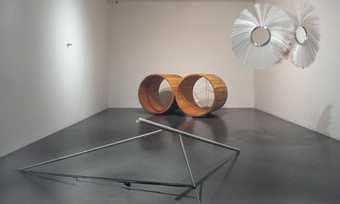Claire Barclay’s sculptural installations balance elements of function and dysfunction, chaos and order, in a precarious equilibrium. Her work pivots around the physical and psychological tensions set up between contrasting components, pitching the organic against the synthetic, the hard against the soft, openness against confinement.
Barclay’s carefully composed environments comprise multiple elements which often respond directly to the specifics of a given space. They combine hand-crafted objects with those manufactured to her own specifications and more improvisatory elements constructed in situ. Objects are grouped and regrouped from one installation to the next; Barclay views each exhibition as a ‘pause’ in her ongoing project refining and adding to a growing vocabulary of forms.
These hybrid objects often suggest a particular function or allude to anthropomorphic or natural forms, yet remain elusive through their careful displacement. This sense of uncertainty is enhanced as the viewer navigates the installation; multiple references unfold gradually over time ensuring that meaning is perpetually evolving and mutating. Barclay uses this ‘area of confusion’ to investigate the complex, shifting and often contradictory relationships between people and their environments and the links between nature, culture and the commodified world.
Exploiting the physical properties of her chosen materials – leather, canvas, metal, rubber or fur, for example – to full effect, Barclay encourages us to engage with her work on a profoundly instinctual level. Invariably, an object’s form and context within the installation combine to trigger a widening range of associations, veering from the domestic and utilitarian to the fetishistic.
The process of making lies at the core of Barclay’s practice. By adopting methods associated with traditional crafts, such as weaving, wood turning and ceramics, she investigates how experience can be communicated through form, responding intuitively to materials and embracing elements of risk and experimentation. These traits are often evident in the finished work, which can be poised between making and unmaking; fraying wicker and dangling threads suggest that process is more important product.
Aside from such formal concerns, Barclay’s interest in craft stems from its affinity to both the functional and the decorative, and the position it now occupies in a culture of mass production. New Age paraphernalia has become a recurring motif in her work; dream catchers, crystals, and other objects that purport to hold mystic or spiritual properties but are now intensively-marketed commodities. Barclay is fascinated by the contradiction inherent in a profit-led industry producing facsimile ‘craft’ objects aspiring to non-commercial values, and our ability to buy into different lifestyles through their acquisition. Similarly, her interest in objects that convey our ambiguous relationship to nature has led her to reference the tools of hunting which, like craft, has become a fetishised and marketed hobby quite detached from its origins.
Half-light, Barclay’s project for Art Now, consists of separate zones, each linked through the loose metaphor of the owl while maintaining their autonomy. Steeped in mythology and a cipher of contradictory beliefs, this predatory creature has variously been associated with wisdom and death, good fortune and witchcraft.
As you enter the space, two floor-based structures impede your passage. Taking their titles from a type of tension-based animal trap, Deadfall 1 and 2 are reminiscent of defunct gymnasium apparatus, manmade surrogates for natural forms. In the first a heavy bar rests on two spindly, tapering legs of differing lengths, creating a distorted tripod shape as if slumping under its weight. In contrast to the hard surface of the machined metal a layer of kid hide clads the bar. The second structure leans into the corner of the room, a thin metal pole with a black leather sleeve attached to its summit acting as both protection and support to a heavier bar. The slit leather strains visibly under the bar’s weight, and appears ready to collapse at any moment.
In the centre of the space, two machined metal hoops are suspended side by side; a halo of thick bristle protrudes from a groove in the outer circumference of each. At the point of their intersection the bristle thrusts forward, creating an owl-like mask and forcing the industrial materials to behave in an organic fashion. The double circle motif is repeated by the two open-ended wooden cylinders positioned side by side on the floor at the far end of the space. Constructed from planks of Douglas Fir the cylinders are roughly hewn on the exterior while sanded and invitingly smooth inside. At one and a half metres in length and diameter, they relate directly to human proportions, encouraging us to bend down and mentally project ourselves inside. Barclay’s use of red leather in the interior further enhances the den-like quality and the separation between inside and outside, suggesting that we are looking into something’s, or someone’s, psyche.
Fixed to the wall and only visible in close proximity, the final element of the installation is a small stainless steel spike that has been slit down the middle and prised apart creating a sharp beak-like form.
Through the juxtaposition of elements of shelter and protection with those of capture and entrapment, Barclay creates a seductive environment charged with an undertone of threat. Her installations operate as a sort of hallucinogenic reflection of the world around us, reliant on the literal and metaphorical references we bring to them while hovering just beyond our realm of experience. Barclay not only acknowledges the power of form and material to communicate on a visual level without recourse to language but also recognises that she is as seduced by as she is sceptical about the commodified world. This duality of emotion underpins her work and perhaps explains her ability to engage so convincingly with the associative properties of her materials. By exploring the slippage between one thing and another, Barclay reveals that meaning is always in motion and impossible to harness.
Text by Lizzie Carey-Thomas

